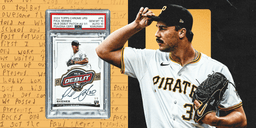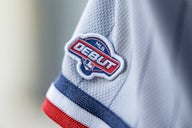Paul Skenes’ 2024 Topps MLB Debut Patch card might have been the most sought-after baseball card in recent memory. It sparked a Willy Wonka-like chase that ended with an 11-year-old boy holding the golden ticket, but then the situation took a turn as conspiracy theories spread.
Following The Athletic’s exclusive interview with the boy who pulled the card and his family, we sort through the biggest questions that surround this story.

GO DEEPER
Exclusive: Hear from the family that found the Paul Skenes MLB Debut Patch card
Who is Paul Skenes and what is a Debut Patch card?
Skenes is a starting pitcher for the Pittsburgh Pirates and the 2024 National League Rookie of the Year. He was selected first overall in the 2023 MLB Draft out of LSU and has quickly established himself as one of the best young pitchers in baseball. In addition to his talents on the field, he’s gained pop culture relevance off it for dating LSU gymnast and social media influencer Livvy Dunne.
Advertisement
Debut Patch cards are the result of the partnership between Major League Baseball and trading card company Topps, which is owned by Fanatics. In 2023, they announced that all players would wear a small Debut Patch on the sleeve of their jersey during their first game in the Majors. That patch would then be removed and put into a one-of-a-kind baseball card autographed by the player and put into a pack of Topps Chrome Update (Topps releases multiple different baseball card sets throughout the year, but this is the only one that includes the Debut Patches).

GO DEEPER
Why MLB rookies are wearing new ‘Debut Patches’ this season
This concept has since been adopted by Major League Soccer and will soon come to the NFL, NBA and perhaps more sports entities as Topps continues to acquire more exclusive licenses to manufacture cards.
Why was this specific card so special?
Given the one-of-a-kind nature of these Debut Patch cards and the inclusion of a particularly unique piece of game-used memorabilia, they have quickly become seen as arguably the most desirable card a collector can get of any player that has one. Skenes’ phenomenal rookie campaign made his Debut Patch card one of the top ones in the product, but it was a social media post from the Pirates that took that interest in it to another level and turned it into a phenomenon that transcended the baseball card community.
How did the Pirates get involved?
2024 Topps Chrome Update was released on Nov. 13. Two days later, the Pirates made a public offer via social media to whoever found the Skenes card. That offer included two season tickets behind home plate for 30 years, plus a variety of unique experiences with Skenes and the team in exchange for the card so the Pirates could put it on public display at PNC Park.
To the lucky person who finds this card… We’d love to bring this card home to PNC Park to share with all Buccos fans.
Here’s our offer: https://t.co/qSDgZg3C8p pic.twitter.com/efNGhjidQ4
— Pittsburgh Pirates (@Pirates) November 15, 2024
The same day, Dunne added to the Pirates’ offer by announcing that whoever found the card could sit with her in her suite at PNC Park for a game. Late Night host Seth Meyers also said that he would give four VIP tickets for a taping of his show to the person who found the card if they just let him look at it for a second.
Advertisement
These offers became national news, established a different kind of value for the card beyond just the monetary and propelled demand for the Chrome Update product to new heights. It quickly sold out and prices rapidly climbed on the secondary market.
How much is the card worth?
We won’t know for sure until it goes up for sale, which will happen in March (more on that in a bit). We do have some imperfect reference points, though.
The most expensive Skenes card to sell as of this writing was his one-of-a-kind 2023 Bowman Chrome Draft Prospects Autographs Superfractor, which sold for $123,220 in September. That card is also a 1/1 and autographed, but it does not have a game-worn Debut Patch on it, so the value just isn’t the same. The most expensive Debut Patch card to sell at auction to date was that of Tampa Bay Rays third baseman Junior Caminero, which sold for $66,000 in December. In July, a $150,000 bounty for the Debut Patch card of New York Yankees shortstop Anthony Volpe was reportedly claimed, as well.
But none of these cards have all the elements that the Skenes Debut Patch card has. Given that, it seems likely the card will sell for six to seven figures.
And this card was just sitting in a pack?
While many of the Debut Patch cards are put directly into packs, the Skenes was a redemption, which means a placeholder card bearing a code that could be entered into Topps’ website in order to claim the real Debut Patch card was put into a pack instead. This is a standard practice by manufacturers whenever a card isn’t signed in time by the player to meet production deadlines or if a certain card is deemed particularly valuable and needs to be protected from potential damage. Once the redemption code is submitted, the card is sent out to the owner by the manufacturer in a protective case.
Advertisement
Who found the Skenes redemption card?
After a months-long search and the majority of the other Debut Patch cards in the 2024 set being found and publicly accounted for, the Skenes redemption card was announced to have been found by an unnamed 11-year-old collector in Los Angeles. The announcement came on Jan. 21 via Topps’ social media posts. No other verification or explanation for why the owner of the card wasn’t named was given at the time.
On Jan. 26, after five days of rampant speculation and growing conspiracy theories, collectibles news site Cllct published further details from Fanatics about the situation, including that the card was first redeemed on Jan. 3 and that delivery of the card was delayed because the family of the 11-year-old had to evacuate their home twice due to the LA wildfires.
Did the 11-year-old take the Pirates’ offer?
No. On Jan. 24, Topps announced that the owner of the card was declining the offer and selling it at auction with Fanatics Collect, an auction house also owned by Fanatics. The card will be auctioned off in March, with the company’s commission on the sale going to L.A. fire relief funds, according to Fanatics Collect.
The Pirates expressed their disappointment that their offer wasn’t accepted, but said they would like to “bring (the boy) to Pittsburgh for a special day at PNC Park this season.” Pirates owner Bob Nutting echoed this sentiment, offering to host the family and facilitate a meeting with Skenes either in Pittsburgh or when the team travels to L.A. But the family told The Athletic that they likely would not do that either, out of an abundance of caution as they continue to protect their anonymity.
Why did people have a problem with how this played out?
It sounded alarm bells for some in the collecting community for several reasons.
Many of the best cards in recent years have either been quickly publicized by their owners across social media or been pulled on camera by breakers (people who typically open large quantities of cards on livestreams and sell the cards off to customers who bought spots based on team, player or other criteria). It’s become so common for this to happen that conspiracy theories have gained traction around the theory that breakers get “loaded” boxes from manufacturers in order to best market the most valuable cards. Topps tried to fight these accusations by commissioning an audit of their randomization practices by KPMG, the results of which were shared in April.
But since the Skenes Debut Patch card wasn’t pulled on camera by a breaker or shared by the owner on their own social media accounts, and the limited information provided only came from Topps, suddenly the scenario that many collectors claimed to have wanted all along — a kid pulling a big card off camera — was suspicious to many. They felt the story seemed too perfect: a child in Los Angeles, an area dealing with devastating wildfires, found the card in a single hobby box gifted to him for Christmas.
Topps’ social accounts also shared images of a journal entry written by the child, which was accused of being fake, as well.
The 11-year-old collector who pulled the Paul Skenes 1/1 Debut Patch card just shared his journal entries…
It’s an absolute MUST-READ 🥹❤️ pic.twitter.com/PldkJMS06W
— Topps (@Topps) January 24, 2025
The fact that the manufacturer of the card was the only source of information about who found it, was actively keeping them anonymous for unspoken reasons, didn’t say where the box was purchased (Topps often names the retailer from which big cards were purchased, whether it be a local hobby shop or a convenience store chain), and another division of Fanatics was set to auction off the card on behalf of the owner all fed into the skepticism in an industry where scams and fraud have been rampant long before Fanatics ever entered into it.
Advertisement
Then there was the matter of the timeline. Once it was revealed that the card was redeemed on Jan. 3 and it wasn’t announced until Jan. 21, Topps was accused of withholding that information and allowing the chase to continue as boxes of Chrome Update continued to sell at inflated prices on the secondary market and in breaks on Fanatics’ own live-selling platform. Topps social media posts on Jan. 4 and 8 highlighting the Skenes card and how it had not publicly surfaced were also questioned.
What did Topps say?
Fanatics Collectibles CEO Mike Mahan said he still doesn’t know neither the name of the boy who pulled the card, nor the names of his parents. It was all part of the process of respecting the family’s wishes to remain anonymous through the process.
“I mean sometimes people want to stay anonymous, but they’re not worried about announcing the card,” Mahan said. “There’s not a lot of intricacy or thought involved in it. Either they want to publicize it, which is most of the time or sometimes they want to publicize it but remain anonymous, which is some of the time. But in this case, you understandably had the highest profile card of the year, arguably, the century. You had a father of an 11-year-old son who wanted to remain private. He was dealing with, and we were all dealing with in L.A. the tragedy of the wildfires.
“So there was just a lot of thought and a lot of complexity here on how we brought this to market. And we wanted to work that out with the father in a way that he felt comfortable with and being unable to connect because of the (Los Angeles area) fires, I think he was evacuated twice, I think it took like two weeks or something before we formally announced it because he wanted to understand and we wanted him to feel good about how he ultimately went to market and how we announced this and how he protected his anonymity.”
What did the family say?
The son knew what he had pulled immediately.
“I opened three packs and then everyone else opened some presents and then I opened one more pack,” the 11-year-old said. “Then on the fifth pack, it was there. I was shocked. It wasn’t even on my mind that I would pull it. I thought it would go to some big breaker. So I’m like, ‘Dad, I pulled the Paul Skenes.’ And he was like, ‘No you didn’t.’”
His father admitted his disbelief.
Advertisement
“I’ve never seen a redemption card before. And so he came over and he showed me this and I initially thought, ‘Well, this is like a promotional card.’ Or like when I was growing up, you get the checklist and the packs. I thought it was something like that.”
The boy’s mother didn’t pretend to understand what had happened Christmas morning initially.
“I’m still catching on, no offense, but who’s Paul Skenes and what is this card worth?” she said about her initial reaction of her son pulling the card. “These guys are collecting all the time, but I was out of the loop. So they started explaining to me more and more. It’s just hard to actually comprehend.”
The family also told The Athletic that the box that had the Skenes card in it was purchased through online marketplace StockX, that the journal entry was written at the mother’s urging so the family could document the moment for the future, that they spoke to two other auction houses (Robert Edwards Auctions and Heritage) before settling on Fanatics Collect, and much more. Read the full story here.
What did Paul Skenes say?
Skenes made an appearance on NBC’s “Late Night with Seth Meyers” earlier this week, just on the heels of the announcement that his card had been hit. Meyers’ first question of the interview was about the MLB Debut Patch card being pulled, with Skenes saying he was “super excited” for the 11-year-old boy. When asked what would’ve been the worst outcome for the card, Skenes said “probably (if) a 50-year-old collector” pulled the card.
The father of the 11-year-old boy said of Skenes’ reaction: “I would say Paul and his girlfriend, their involvement and the excitement about the card is so cool. I just think the whole thing has been fun and hearing him remark about how happy he was, you can’t help but be happy along with that. You know, because our kid, boil all of this down, pulling a card out of a pack is like the backbone of this whole thing that we call collecting. And so the fact that our kid by luck pulled that card, it’s amazing. It is fun, I’m thrilled that he (Skenes) felt the same way.”
Where is the card now?
The father told The Athletic that a Fanatics executive escorted the card from Topps’ office in Dallas to Los Angeles last week. It was brought to the family’s house and the boy got to spend some time with it. The next day, it was brought to PSA (Professional Sports Authenticator) for grading, where it went through an expedited, one-day grading process and received gem-mint 10 grades for both the card and the autograph on it. Since the card was consigned for auction, it was then brought to the east coast by a Fanatics Collect representative where it will begin a promotional push ahead of going up for sale.
Advertisement
What happens next?
Next up is the auction in March, where anyone who has sufficient funds can bid on the card. The unique level of scrutiny around the card and story could push the price higher than it otherwise would reach.
The 11-year-old told his parents he’d like to use the money from the sale for his and his brother’s college education. But he also wants to put some aside for more packs of cards.
Follow The Athletic’s regular, in-depth sports memorabilia and collectibles coverage here.
The Athletic maintains full editorial independence in all our coverage. When you click or make purchases through our links, we may earn a commission.
This post was originally published on this site be sure to check out more of their content.






